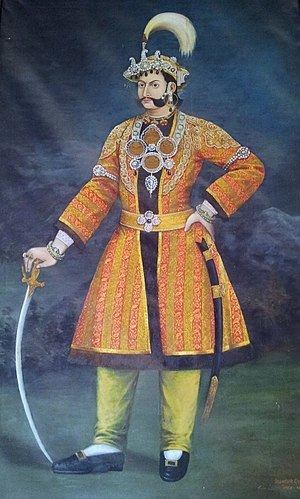Name Mathabarsingh Thapa | ||
 | ||
Mathabar Singh Thapa listen (Nepali: माथवरसिंह थापा) was the Prime Minister and Commander in chief of the Nepalese Army from 1843 December 25 – 1845 May 17, until he was murdered by his nephew Jung Bahadur Rana. He was the nephew of Bhimsen Thapa, who was falsely sentenced for imprisonment for the death of King Rajendra's six months old son. Mathabar Singh Thapa fled to Shimla after the execution of Bhimsen Thapa, to avoid his own execution as he was Bhimsen’s nephew. Four years later, the second queen of Rajendra, Queen Rajya Lakshmi, called him back and installed him as the Prime Minister. Mathabar Singh, however, enraged the queen by refusing to make her son, Ranendra Bikram, the king. The queen, in turn, had him shot by his own nephew Janga Bahadur Rana.
Contents
Early years
Not much is known of Mathabar Singh Thapa's childhood. He was born in Borlang, Gorkha. He was the son of Kaji Nayan Singh Thapa who was killed in the war against the Kingdom of Kumaon. He was a nephew of Bhimsen Thapa and also the maternal uncle of Jang Bahadur Rana. Through his mother's side, he was the grandson of Kaji Ranajit Pande, who was the son of Kaji Tularam Pande. Kaji Tularam Pande was a cousin of Kaji Kalu Pande.
Rise to Power
Mathabar Singh Thapa, who was exiled to India when Bhimsen Thapa was supposedly found to be guilty of murdering the King Rajendra's son who was 6 months old, was asked to return to Nepal by the queen. Mathabar Singh Thapa arrived in Kathmandu Valley in 1843 April 17 where a great welcome was organized for him. After consolidating his position, he successfully led to the murder of all his political adversaries Karbir Pandey, Kulraj Pandey, Ranadal Pandey, Indrabir Thapa, Radabam Thapa, Kanak Singh Mahat, Gurulal Adhikari and many others, in several pretexts. The second queen of Rajendra, Queen Rajya Laxmi declared him Minister and Commander-In-Chief of the Nepalese army in 1843 December 25 believing he would help to usurp the power from Rajendra, her own husband, and make her own son, Ranendra as the king of Nepal.
Consolidation of Power
Before he was made the Minister and the Commander-In-Chief, he had led to the murder of almost all of his enemies and political adversaries. Having seen the fall of Bhimsen Thapa, he believed that having a personal army would prevent his own downfall; so he raised three regiments dedicated to him and only him. He built army barracks around his house for his personal protection. For this, he used the army like slaves, for which the resident Sir Henry Lawrence advised him not to do so. However, too over-confident in his power, MathabarSingh Thapa ignored him. He even claimed that since the time of Prithvi Narayan Shah, he would be the first Prime Minister to die of old age and not out of conspiracy. In 1845 January 4, he declared himself as the "Prime Minister of Nepal". This was the first time anyone had been titled "Prime Minister" in the history of Nepal. All before him were either titled as Mukhtiyar or Mul Kajis. It is believed that at that time he had become even more powerful than the King of Nepal. His power and over-influence in the Nepalese politics and even in the personal life of the monarchy itself led to the eclipse of his power and his downfall by the hands of Jang Bahadur Rana.
Downfall
When Mathabar Singh Thapa declined the Queen's request to help her make her own son king, the Queen joined those against him and plotted his downfall. But just to appease him, he was provided the title of "Prime Minister" while conspiracy to murder him was going on behind. Finally, when all the preparations for his murder were made, he was called to the Royal Palace at night, informing him incorrectly, that the Queen had been ill from some disease. Though he was warned by his own son, and his mother, he went to the palace. When he was sleeping Jang Bahadur was hiding under his bed. He was shot multiple times on his back from under the bed by Jang Bahadur Rana where he immediately died. The next day King Rajendra declared that he had himself killed Mathabar Singh Thapa accusing him of several activities that he had done to undermine his own (Rajendra's) power.
Aftermath
The murder of Mathabar Singh Thapa led to the political instability in Nepal. Though, Fatte Jungh Shah was declared the Prime Minister (1845 September 23), Gagan Singh had more regiments (7) of the army under him and was more powerful. Jung Bahadur Rana also had 3 regiments under him. Fatte Jungh Shah himself had 3 regiments of the army under his control. Also Gagan Singh had the special support of the queen Rajya Laxmi Devi. British Resident Sir Henry Lawrence once mentioned that, "If there is struggle for power, that struggle will be between Gagan Singh and Jung Bahadur." Ultimately, the extreme power of Gagan Singh led to his assassination by King Rajendra and Prime minister Fatte Jungh Shah in 1846 September 14 at 10 P.M.. The assassination of Gagan Singh led to the Kot massacre and ultimately, the rise of Jung Bahadur Rana.
Legacy
Mathabarsingh Thapa was the first prime minister of Nepal to wear a crown. The 104 year-ruling Rana Dynasty was also related to him.
